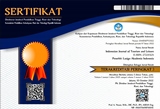Efektivitas Instagram dalam Meningkatkan Minat Kunjungan Wisatawan di Daerah Istimewa Yogyakarta
Abstract
Promotion and marketing through social media becomes a strategic issue during a pandemic, due to there are various restrictions on activities. One of the popular social media is Instagram. Instagram provides features for editing photos, editing videos, messaging, sharing photos and videos, and sharing reviews or reviews. The Yogyakarta Special Region tourism office (D.I.Y) uses Instagram as the main social media in the promotion and marketing of tourist destinations in D.I.Y. This study aims to review the effectiveness of the use of Instagram by measuring the extent to which the influence of the ability of tourists to access Instagram and the quality of Instagram on the interest in tourist visits in the Special Region of Yogyakarta. The study used a quantitative descriptive approach by conducting a survey of 200 respondents. Data measurement used a 5-point Likert scale and analyzed using linear regression techniques. The results showed that there was a significant positive influence between the ability of tourists to access Instagram and the quality of Instagram on the visiting interest, both partially and simultaneously. The quality of Instagram has a dominant influence of 40%, compared to the ability of tourists to access Instagram, which is 19.9%. The variable access ability and quality of Instagram contributed 53.2% to the visiting interest, while the remaining 46.8% was explained by other variables not involved in this study.
Full Text:
PDFReferences
Atiko, G., Hasanah Sudrajat, R., & Nasionalita, K. (2016). Analisis Strategi Promosi Pariwisata Melalui Media Sosial Oleh Kementrian Pariwisata RI (studi deskriptif pada akun Instagram @indtravel). Jurnal Sosioteknologi, 15(3), 378–389. https://doi.org/10.5614/sostek.2016.15.3.6
Baker, A. M., & Donthu, N. (2015). © 2015, American Marketing Association. 404–413.
Bergström, T., & Bäckman, L. (2013). Marketing and PR in Social Media : How the utilization of Instagram builds and maintains customer relationships. Media and Communication, 56.
Bevins, C. (2014). Get Schooled: A Visual Social Semiotic Analysis of Target’s Branding using Instagram. Zhurnal Eksperimental’noi i Teoreticheskoi Fiziki, 1–133.
Carah, N., & Shaul, M. (2016). Brands and Instagram: Point, tap, swipe, glance. Mobile Media and Communication, 4(1), 69–84. https://doi.org/10.1177/2050157915598180
Cowden, A. . (2014). Effect of Social Media Marketing on Traditional Marketing Campaigns in Young Icelandic Companies. Reykjavik.
Dennis, D. (2014). Successfully Social: A Non-Profit’s Guide to Modern Social Media Marketing. Senior Honours Thesis, 1–32.
Deru, R. ., & Cindy, J. (2017). Media Sosial Instagram Sebagai Sarana Promosi Untuk Meningkatkan Minat Beli Konsumen. Jurnal Bisnis Terapan, 1(01), 25–32. https://doi.org/10.24123/jbt.v1i01.296
Dewing, M. (2017). Social media: An Introduction. Parliamentary Information and Research Service, Social Affairs Division. Canada: Library of Parliament.
Djafarova, E., & Rushworth, C. (2017). Exploring the credibility of online celebrities’ Instagram profiles in influencing the purchase decisions of young female users. Computers in Human Behavior, 68, 1–7. https://doi.org/10.1016/j.chb.2016.11.009
Dobele, A., Lindgreen, A., Beverland, M., Vanhamme, J., & van Wijk, R. (2007). Why pass on viral messages? Because they connect emotionally. Business Horizons, 50(4), 291–304. https://doi.org/10.1016/j.bushor.2007.01.004
Doh, S. J., & Hwang, J. S. (2009). How consumers evaluate eWOM (electronic word-of-mouth) messages. Cyberpsychology and Behavior, 12(2), 193–197. https://doi.org/10.1089/cpb.2008.0109
Ellya. (2015). Promosi Wisata Lebih Cepat Lewat Sosmed dan Media Sosial.
Goyette, I., Ricard, L., & Bergeron, J. (2010). e-WOM Scale : Word-of-Mouth Measurement Scale for e-Services Context *. 23, 5–23.
Herman, J. (2014). How to use Instagram to improve your marketing.
Hird, C. (2013). Social media marketing: A best practices analysis of selected destination magazines.
Hudson, S., & Hudson, D. (2006). Branded Entertainment: A New Advertising Technique or Product Placement in Disguise? Journal of Marketing Management, 22(5–6), 489–504. https://doi.org/10.1362/026725706777978703
Jadhav, N.P, Kamble, R, S., & Patil, M. . (n.d.). Social Media Marketing: The Next Generation of Business Trends. IOSR Journal of Computer Engineering (IOSR-JCE), 45–49.
Jalilvand, M. R., & Samiei, N. (2012). The effect of electronic word of mouth on brand image and purchase intention: An empirical study in the automobile industry in Iran. Marketing Intelligence and Planning, 30(4), 460–476. https://doi.org/10.1108/02634501211231946
Kim, A. J., & Ko, E. (2012). Do social media marketing activities enhance customer equity? An empirical study of luxury fashion brand. Journal of Business Research, 65(10), 1480–1486. https://doi.org/10.1016/j.jbusres.2011.10.014
Knibbs, K. (2013). Want to make money? Study says Instagram beats Twitter, Facebook in brand engagement.
Kurniawati, W. D. N. (2017). Pemanfaatan Instagram Oleh Komunitas Wisata Grobogan Dalam Mempromosikan Potensi Pariwisata Daerah. Komuniti: Jurnal Komunikasi Dan Teknologi Informasi, 8(5), 127. https://doi.org/10.23917/komuniti.v8i5.2943
Kusuma, D. F., & Sugandi, M. S. (2019). Strategi Pemanfaatan Instagram Sebagai Media Komunikasi Pemasaran Digital Yang Dilakukan Oleh Dino Donuts. Jurnal Manajemen Komunikasi, 3(1), 18. https://doi.org/10.24198/jmk.v3i1.12963
Kwek, C. L., Tan, H. P., & Lau, T. C. (2010). Investigating the shopping orientations on online purchase intention in the e-commerce environment: A Malaysian study. Journal of Internet Banking and Commerce, 15(2), 1–22.
Lin, T. M. ., Lu, K., & Wu, J. (2012). The effects of visual information in eWOM communication. Journal of Research in Interactive Marketing, 6(1), 7–26. https://doi.org/10.1108/17505931211241341
Linaschke, J. (2011). Getting the most from Instagram. Berkeley: Peachpit Press.
Madahi, A., & Sukati, I. (2012). The Effect of External Factors on Purchase Intention amongst Young Generation in Malaysia. International Business Research, 5(8). https://doi.org/10.5539/ibr.v5n8p153
Maravic, A. (2013). Through the photo-chromic lens of the beholder: The development of the simple holiday photography to a marketing product. Modul Vienna.
Martin, K., & Todorov, I. (2010). How Will Digital Platforms be Harnessed in 2010, and How Will They Change the Way People Interact with Brands? Journal of Interactive Advertising, 10(2), 61–66. https://doi.org/10.1080/15252019.2010.10722170
Nasrullah, R. (2015). Media Sosial: Prosedur, Tren, dan Etika. Bandung: Simbiosa Rekatama Media.
Neti, S. (2011). Social media and its role in marketing. International Journal of Enterprise Computing and Business Systems, 1(2), 1–14.
Rezvani, S., Dehkordi, G. J., Rahman, M. S., Fouladivanda, F., Habibi, M., & Eghtebasi, S. (2012). A conceptual study on the country of origin effect on consumer purchase intention. Asian Social Science, 8(12), 205–215. https://doi.org/10.5539/ass.v8n12p205
Rochman, A., & Iskandar, P. (2015). Users’ Engagement Toward the Brand Accounts in Instagram Based on the Aisas Model. Journal of Business and Management, 4(8), 890–900.
Saravanakumar, M; Lakshmi, T. . (2012). Social media marketing. Life Science Journal, 9(4).
Schiffman, L. ., & Kanuk, L. L. (2007). Consumer Behavior, ninth ed. New Jersey: Prentice-Hall Inc.
Setiawan, E. B. (2017). Quality and Purchase Intention Percieved Towards low Cost Energy- Saving Cars. Jurnal Manajemen Transportasi Dan Logistik, 2(1), 107. https://doi.org/10.25292/j.mtl.v2i1.135
Shih, T.-Y. (2010). Comparative Analysis of Marketing Strategies for Manufacturers’ and Retailers’ Brands. International Journal of Electronic Business Management, 8(1), 56–67.
Silva, T. H., Melo, P. O. S. V. De, Almeida, J. M., Salles, J., & Loureiro, A. A. F. (2013). A picture of instagram is worth more than a thousand words: Workload characterization and application. Proceedings - IEEE International Conference on Distributed Computing in Sensor Systems, DCoSS 2013, (i), 123–132. https://doi.org/10.1109/DCOSS.2013.59
Sugiyono. (2011). Metode Penelitian Kuantitatif Kualitatif dan R&D. Bandung: Bandung: Alfabeta.
Teng, L., Laroche, M., & Zhu, H. (2007). The effects of multiple-ads and multiple-brands on consumer attitude and purchase behavior. Journal of Consumer Marketing, 24(1), 27–35. https://doi.org/10.1108/07363760710720966
Trihayuningtyas, E., Wulandari, W., Adriani, Y., & Sarasvati, S. (2019). Media Sosial Sebagai Sarana Informasi Dan Promosi Pariwisata Bagi Generasi Z Di Kabupaten Garut. Tourism Scientific Journal, 4(1), 1. https://doi.org/10.32659/tsj.v4i1.46
Uzunian, S. (2013). Factors affecting “Internet marketing” campaigns with reference to viral and permission marketing. The IUP Journal of Management Research, 9(1), 26–37.
Weber, L. (2007). Marketing to the Social Web: How Digital Customer Communities Build Your Bussiness. New Jersey: Wiley.
DOI: https://doi.org/10.36256/ijtl.v2i1.138
Refbacks
- There are currently no refbacks.
Copyright (c) 2021 Indonesian Journal of Tourism and Leisure

This work is licensed under a Creative Commons Attribution-NonCommercial-ShareAlike 4.0 International License.
Indonesian Journal of Tourism and Leisure Indexed and Archieved By:

Indonesian Journal of Tourism and Leisure is licensed under a Creative Commons Attribution-NonCommercial-ShareAlike 4.0 International License.














